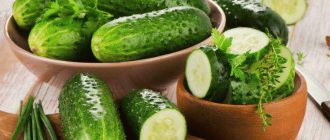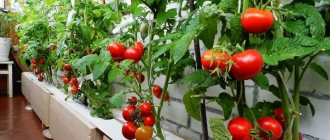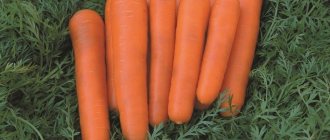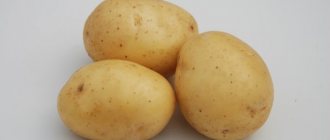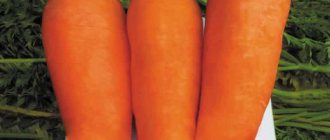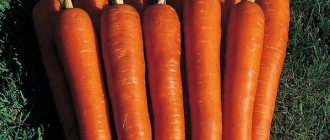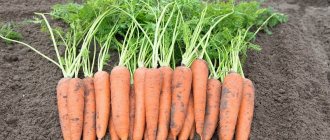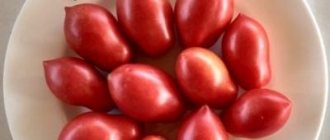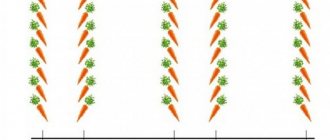Early varieties of carrots
Early ripening carrot varieties include varieties that can produce fruit within 50–80 days from the moment of germination, which is especially valuable for those who want to harvest several harvests a year. The most popular crops of Dutch selection in this case are Bureau and Red Core.
This carrot variety is not just early ripening, but very early, since in most cases the first harvest is harvested already on the 60th day after germination. The root vegetable itself is characterized by high juiciness and tender pulp, and its even and symmetrical shape with a smooth surface only improves its overall commercial qualities. The weight of one bright orange carrot reaches 250 g, with a fruit length of 16–18 cm.
If you harvest the crop during its full ripening period (up to 8 kg per 1 m²), the root crops will be successfully stored for about 4 months. Bureau plants are resistant to bolting and are excellent for fresh consumption, especially since the root vegetables do not have a pronounced core. When caring for carrots, proper watering is very important, and seeds can be sown both in the closed soil of greenhouses and directly in the beds.
Red Cor plants are more common than other Dutch varieties in the European part of the Russian Federation and usually produce a harvest 70–80 days after germination. When ripe, all root vegetables have an intense orange color, juicy pulp and a conical shape. The length of one carrot reaches 15 cm and weighs 150–180 g, although it is possible for carrots to ripen weighing up to 250 g.
The inner part of the root crop is characterized by uniform pulp and a small core, the tops are smooth and strong, rich green in color. With regular watering, the bitter taste is completely eliminated, and these carrots are not prone to the accumulation of nitrates, which significantly increases their beneficial properties. To increase the frost resistance of Red Cor plants, it is worth sowing the crop in winter, and to harvest the crop earlier, sow carrots in the spring. The average yield of the variety is 4 kg per 1 m².
- The main advantages of this variety include:
- good commercial quality;
- high taste data;
- increased resistance to diseases and bolting.
The best varieties of seeds for open ground, which ones to choose and why
Everyone loves carrots. Not only to eat, but also to grow. This biennial plant is considered a highly profitable vegetable crop.
Good productivity allows you to grow root crops for freshly harvested consumption, freezing, processing, preparation, canning and storage.
Many varieties do not lose their nutritional value and taste until early spring. In recent years, gardeners have given preference to carrot seeds of Dutch selection.
Dutch breeders are considered one of the best producers of vegetable crops. Seeds of well-known brands are distinguished by their versatility, fast and high-quality germination, and vegetables:
- high productivity;
- disease resistance;
- excellent taste;
- high quality trade dress.
Carrot varieties from Holland stand out among domestic seeds precisely because of their attractive appearance and juiciness. Carrots are grown in three types - early ripening, medium ripening and late. In addition, each type differs in:
- Shape and length of root crops.
- Yield levels.
- Content of vitamins, sugars and carotene.
In recent years, hybrids or hybrid seeds have become especially popular. These are species obtained by controlled crossing of two selected varieties. They are selected according to certain indicators that the hybrid must have. Main characteristics of hybrid carrot seeds:
- high percentage of germination;
- genetic similarity;
- unusual shape and color of the fruit;
- high shelf life and excellent presentation.
Hybrid seeds are bred to fully satisfy the needs of gardeners. In this case, all the requirements that apply to a particular culture are taken into account. For carrots, the germination percentage is very important, because usually the seeds sit in the ground for a long time. Also shelf life. Fresh root vegetables are extremely in demand in winter to replenish the supply of vitamins and carotene for the body.
Agronomists believe that half of the harvest directly depends on the quality of the seeds. Dutch carrot seeds are considered the most productive and sustainable. The quality of the crop is not affected by weather conditions, the crop is almost not damaged by pests and tolerates drought or low temperatures without loss.
The best of the Dutch manufacturers are considered to be Monsanto and Nunems. But even the most proven varieties of carrots from Holland need to be sown in prepared soil, watered and loosened, and the growth of the plants observed.
To decide on the choice of variety for your site, you should familiarize yourself with the list of main names of Dutch carrots.
"The Bureau"
Super early Dutch carrots. The variety has gained popularity for:
lack of core;
- harmonious appearance of root vegetables;
- excellent taste;
- plant resistance to bolting.
The first harvest is harvested 60 days after germination. This is the so-called bunch carrot; to obtain it, the seeds are sown as early as March. Depending on the sowing time, the harvest is obtained from May to October. The variety is suitable for winter sowing (October–November).
Root crops are completely immersed in the soil, have a flat, smooth surface, reach a length of up to 20 cm and a weight of 250 g. The color is intense orange. The characteristics of the variety include disease resistance, high stable yield, and storage ability (up to 4 months). Seeds are sown to a depth of no more than 2.5 cm in grooves about 5 cm wide.
The variety requires proper watering. It needs regularity and moderation. Designed for greenhouses and open ground.
"Red Core"
Another early variety. Belongs to the Shantane type. The maturity of root crops occurs 70-85 days after the appearance of full shoots. Carrots with intense orange color and juicy flesh.
The shape of the root crops is conical, small in size (up to 15 cm). The tops of the plant are powerful and healthy. Recommended for early production and storage. In order for root crops to withstand the winter well, winter sowing should be carried out.
For early harvest - spring. Advantages of the variety:
- high-yielding;
- high-quality presentation;
- excellent taste characteristics;
- resistance to bolting and diseases;
- does not accumulate nitrates with proper application of fertilizers.
Used fresh and for processing.
"Campo"
Mid-season varietal carrots from Dutch producers. Ripening period is 100-110 days. The roots are smooth, cylindrical, very attractive. They grow up to 20 cm in length and weigh 100-150 g. The pulp is orange with excellent taste and a high degree of juiciness. The variety is valued for:
- suitability for freezing and processing;
- resistance to shooting;
- possibility of mechanical cleaning;
- high stable yield;
- good keeping quality.
The taste is excellent, the variety is suitable for dietary nutrition.
"Romos"
One of the highest-yielding medium varieties. Harvesting is carried out 120 days after emergence. The root vegetables are smooth and large with a pointed tip, reach a length of 23 cm and gain weight up to 250 g. Carrots are easily pulled out of the soil, which reduces the possibility of damage. The core and flesh are the same bright orange color. Peculiarities:
- resistance to cracking and breaking of fruits;
- stores well (up to 8 months);
- productivity is maintained on all types of soil (up to 6.5 kg/sq.m).
Sowing of seeds is carried out from the end of April without soaking. All seeds are processed by the manufacturer. Planting depth is no more than 2 cm. Suitable for winter sowing, which is carried out from the end of October.
Seedlings must be thinned and weeded. The variety does not tolerate stagnant water, so it requires loosening and normal watering.
For long-term storage, it is necessary to observe the temperature and humidity conditions in the room.
"Karini"
An excellent variety that retains its taste and commercial qualities for a long time. Valued for its high percentage of carotene content, pleasant taste, and unpretentiousness to growing conditions.
Technical ripeness occurs 115–130 days after emergence. The weight of root vegetables ranges from 100 to 160 g, the average length is 15 cm. Suitable for fresh use, canning, freezing and processing.
The pulp is rich orange. Productivity reaches 3.8 kg per 1 sq. m of planting area.
Advice! Optimal time for sowing: late April - early May. Seeds are sown in rows with a row spacing of 20 cm to a depth of 1 cm.
"Vita Longa"
A well-known mid-late, high-yielding variety loved by many gardeners. "Vita Longa" is known for its keeping quality, preservation of taste and nutritional qualities during storage.
Grows well on any soil without fear of reduced yield. Proper feeding helps increase the number of root crops.
The variety has good resistance to diseases and pests, which makes it very beneficial when grown in small areas.
Root crops do not crack and retain their presentation for a long time. Excellent taste, high percentage of carotene content, juicy pulp make the variety very widespread. Fruit length 25-30 cm, weight 250 g.
Technical maturity occurs 115 days after germination. The harvest is harvested from mid-July to October, depending on the sowing time. Seeds are sown according to a 20x4 cm pattern, planting depth is 2 cm.
The yield of the variety is up to 7 kg per 1 sq.m.
Hybrids of Dutch selection
Among Dutch carrots, hybrids are highly valued. This is due to the set of qualities that root vegetables possess. There are a lot of popular types, so hybrid varieties of carrots have their own catalogs and detailed descriptions.
"Laguna F1"
An early ripening hybrid with cylindrical root crops. Variety Nantes. Technical ripeness occurs after 80 days. The flesh is rich orange in color with a very small core.
The fruits are 18-20 cm long and cylindrical in shape. The average weight of one carrot is 135 g. Seeds are sown according to a 15x4 cm pattern with a seed depth of up to 2 cm. Loves loose sandy soil with good lighting.
Advantages of the variety:
- disease resistance;
- excellent taste;
- suitability for baby and dietary nutrition;
- good yield (6.8 kg per 1 sq. m).
Designed for growing in open ground. Used fresh.
"Bangor F1"
Mid-season high-yielding hybrid (Berlicum variety). The harvest is harvested 110 days after full germination. It is considered the most productive. The root vegetables are heavy (up to 400 g), long (22 cm) with a blunt tip. They have excellent taste and pleasant color.
Carrots are distinguished by a high percentage of carotene, suitability for mechanical harvesting and long-term storage. Suitable for fresh consumption, freezing, processing and canning.
The hybrid is very resistant to diseases, blooming, cracking and brittleness. The peculiarity of the variety is that before sowing, be sure to moisten the soil well and not thicken the plants. Demanding about loosening, watering and nutrition.
It is considered a universal hybrid for regions with warm climates.
"Koltan F1"
One of the new late-ripening hybrids (up to 140 days). Belongs to the Flacian-Nantes type. Intended for fresh use and processing, well stored. The root crops are smooth, heavy (up to 200 g) and long (22 cm). The shape of root crops depends on the density of sowing. With low density they have a conical shape, with high density they have a cylindrical shape. Hybrid features:
- excellent resistance to Alternaria and downy mildew;
- good keeping quality (up to 7 months);
- high percentage of carotene content;
- possibility of mechanized cleaning;
- stable fruiting on all types of soil.
Recommendations for cultivation - sowing is carried out on the ridges.
Conclusion
Carrots of Dutch selection give an excellent harvest if the cultivation technology is followed. This is especially important in large areas and on farms. All varieties correspond exactly to the description, have excellent taste and presentation. Growing carrots of Dutch varieties is quite easy even for novice gardeners.
Carrots occupy one of the leading positions among vegetables in terms of vitamin content, taste and nutritional value. The vegetable is consumed fresh, prepared from the root crop, and stored in the cellar. Not all varieties of vegetables are suitable for winter storage; to select seeds, it is important to study basic information about varieties and hybrids. The article provides information on how to test carrot seeds for germination.
Top 5 varieties of carrots
There is a wide variety of carrot varieties. To decide on the most suitable option, you need to know the main points regarding the gradation of varieties. Conventionally, all varieties and hybrids of carrots are divided into:
- Time of sowing seeds (spring and autumn planting);
- Ripening period (early, mid-ripening, late);
- Planting conditions (open, protected ground);
- Storage (degree of keeping quality, for fresh consumption, how many weeks it can be stored).
Source: https://planeta-dachi.ru/dom/rannie-sorta-morkovi-gollandskoy-selektsii/
Medium varieties of Holland
The ripening period of these carrot varieties ranges from 80–115 days after germination, and the most famous varietal varieties of root crops of Dutch selection include the Campo and Romos varieties.
The fruits of this carrot variety are recommended for long-term storage, canning and even freezing, being characterized by high juiciness and sweetness. It will be possible to harvest the crop 100–110 days after germination, but it is not always possible to achieve smooth ripening. The above-ground part of the crop is erect, voluminous, with long, dark green, finely dissected leaves.
Root crops are cylindrical in shape, deep orange in color, with a slight bumpiness of the surface cover. The length of one Kampo carrot is 20 cm, and its weight ranges from 100–150 g. The main advantages of the carrots described are suitability for processing, the possibility of mechanical harvesting, resistance to arrows, good shelf life of the harvested crop, and suitability for dietary nutrition.
A high-yielding variety of medium ripening, harvesting is carried out approximately 110–120 days after seedlings emerge. When ripe, all root vegetables are distinguished by a smooth surface, a pointed tip and a length of 23 cm with a weight of about 250 g. Harvesting is very simple, since it is easily removed from the soil and is practically not damaged during further transportation.
The outer color of the root vegetables is simply orange, but the pulp inside is richer and very juicy. 1 m² of plantings usually brings up to 6.5 kg of harvest, which on average is stored for up to 6–8 months (in the cellar). Carrots are suitable for winter sowing, starting at the end of October - however, do not forget that this variety does not tolerate waterlogging and requires constant loosening of the soil on the site.
Carrot Samson: reviews, photos, characteristics, variety description
There are many varieties of carrots. Some of them are popular among summer residents due to their unpretentiousness, others due to their wonderful taste. Still others are versatile and suitable for both fresh consumption and long-term storage and canning. Samson carrot combines all these three qualities. Reviews about it from gardeners are simply wonderful. According to domestic summer residents, this is the most delicious variety of all unpretentious ones.
What kind of selection?
So what are Samson carrots? We will give a description of the variety below. First, let's look at where it came from on the domestic market and what kind of company supplies its seeds. The producer of planting material of this variety is the largest agricultural corporation Bejo Zaden. This Dutch company has branches in many countries around the world. She specializes in seed production and selection. Currently, it employs more than 800 people (200 abroad). Seeds are supplied to markets in different countries by distributors. This manufacturer mainly specializes in the production of carrots, beets and cabbage. The seeds of this company are imported into Russia by, for example, a commercial company.
general description
The Samson carrot, which has very good reviews from summer residents, belongs to the Nansk variety. That is, it has long (up to 20 cm) cylindrical roots with a blunt end. The main distinguishing feature of this carrot is its very sweet, tender, juicy pulp. The root color is orange. The core in it is very thin and fits tightly to the pulp. Carrots can be stored in a cool place until next year. It is often used in preparing hot dishes and salads, as well as in canning cabbage, eggplant, peppers, etc. You can pickle or salt these carrots separately, in their pure form.
When grown, the root crop is completely immersed in the ground. Its weight can reach 125-150 g. The variety is classified as mid-season. It contains 10% dry matter.
The Samson variety is currently considered one of the leaders in world selection. Its yield is as much as 40% higher than that of the popular Nantes carrot 4. The ripening time of the variety is 110-120 days.
Carrot Samson: reviews from summer residents
Domestic gardeners have simply wonderful opinions about this carrot. It is praised by residents of both the European part of the country and the southern regions, as well as the Urals and Siberia. Good germination, large size, and high yield of this variety are noted. Summer residents also like the unusual shape of the root vegetable with a blunt tip that never rots during storage.
Many people use these carrots to make sweet juices and purees. The fruits of this variety are even, but have small tubercles. Samson carrots are stored, reviews of the taste of which are simply excellent, according to summer residents, not bad. However, in this regard it is somewhat inferior to late-ripening varieties of domestic selection. According to most, it is best suited for fresh consumption, as well as for pickling cabbage, as it gives a lot of juice.
Among the disadvantages, summer residents mainly note the inability to buy seeds of this variety. In small towns it is difficult to find them. That's why many people order these carrots online. If you wish, you can find both regular and granulated seeds on the Internet.
How and when to plant?
Like most other varieties, Samson carrots, reviews (photos of root crops can be seen on the page), which allow us to judge it as one of the best today, are planted in the middle zone in mid-late April immediately in open ground. The best predecessors for it are cabbage, cucumber and potatoes. It is not recommended to plant carrots next to dill. Fertile, loose soil or loam is best suited for growing the Samson variety. It is recommended to fertilize the bed only with mineral compounds. Carrots do not like organic fertilizers. When manure or compost is added to the soil, root crops grow ugly, shaggy, lose their taste and are very poorly stored. It is recommended to plant carrots of this variety, like any other, in an area that is well cleared of weeds. Weeding young plants is extremely difficult. If grass grows in the garden bed, it can simply “clog” the planting.
For planting, of course, it is better to choose Samson granulated carrot seeds. Reviews of this material from summer residents are better than the usual ones. After all, in this case there is no need to thin out the planting. Bury the seeds into the soil by about 1-2 cm. Then they are covered with earth, carefully water the bed and go through it with an inverted rake, slightly compacting the soil.
Features of care
Samson carrots planted with regular seeds are thinned out twice a season. The first time is after the emergence of seedlings, the second time is after the root crops reach a centimeter in diameter. The last time the operation is performed in such a way that there is at least 5-6 cm of free space between the plants. This will allow each root crop to develop normally.
Samson carrots are fertilized immediately after germination and a couple of weeks after that. In summer, as during planting, mineral fertilizers are used. You can take a complex one.
The carrot variety Samson (reviews confirm this) requires watering, and quite abundantly. The soil should not be allowed to dry out, especially at the beginning of growth. During rainy periods, watering can be done less frequently; during dry periods it will have to be done more often.
Harvesting
In central Russia, Samson carrots, described above, begin to ripen in mid-summer. In July, it can already be pulled out for salads and roasts. Dig up carrots in August, carefully lifting the lump with a shovel. Root crops are laid out along the edges of the bed to dry, and then the tops are removed and lowered in boxes into the cellar for storage. Containers can be used in plastic, wood or metal. The main thing is that they are lattice. It is advisable to place anti-rodent tablets in the cellar.
What can you cook from delicious root vegetables?
How to make puree?
To prepare this dish you will need to take 2 Samson carrots, 30 ml of milk, salt and one teaspoon of olive oil. Make the puree as follows:
- The carrots are thoroughly washed and the outer skin is peeled off.
- Next, it is cut into small cubes, placed in a pan and filled with water so that the product is completely covered.
- Place the pan on low heat and wait for the water to boil.
- The finished carrots are rubbed through a sieve.
- Add boiled milk and olive oil to the pulp.
- Mix everything thoroughly.
The puree should be stored in the refrigerator.
A quick way to pickle cabbage and carrots
As already mentioned, this variety is often used for pickling cabbage. The juice of Samson root vegetables gives the mass a pleasant orange tint and also improves its taste. Next, we present to your attention a recipe for quick pickling of cabbage with carrots of this variety. For canning you will need to prepare:
- white cabbage - 1.5 kg;
- carrots - 3 pcs.;
- sugar - 100 g;
- vegetable oil - 100 ml;
- vinegar - 100 ml (9%);
- black pepper - 5 peas;
- garlic - 3 cloves;
- salt - 1.5 tbsp. l;
- water - 500 ml.
The cabbage should be cut into strips, the carrots should be grated, and the garlic should be cut into thin slices. Next, all the vegetables are mixed and lightly pressed so that a little juice is formed. The brine is prepared as follows:
- water is poured into the mug;
- add salt, sugar and pepper;
- place the container on the fire and boil for a couple of minutes;
- Oil and vinegar are added to the hot mixture.
After boiling again, the brine is poured into the vegetables. Next, the mass is thoroughly mixed and transferred to an enamel pan. The vegetables with brine need to be pressed down with something on top. The cabbage should stand under pressure for about 7-8 hours. Then it can be transferred to glass jars.
Well, we hope we have answered the question of what Samson carrots are in sufficient detail. The characteristics and reviews about it are now known to you. As you can see, this root vegetable is very unpretentious, tasty and certainly suitable for growing in Russia. Reviews about this variety from domestic summer residents are only positive. If seeds are not available in specialized stores, it is very easy to purchase them online.
fb.ru
Mid-late and late
Carrots of mid-late and late ripening are less in demand than previous options, since almost every gardener strives to get a harvest as quickly as possible. Medium-late or, especially, late root crops are usually ready for harvesting only after 115–150 days of cultivation, but this does not in any way affect their positive qualities. Of the professional carrot varieties of Dutch selection, the most famous are Carini and Vita Longa, grown mainly in the central and southern regions of the Russian Federation.
This variety bears fruits approximately 110–115 days after germination, and they are all characterized by a bright orange color, reminiscent of the color of the setting sun. One Carini carrot weighs on average about 150 g, and from 1 m² of plantings up to 4 kg of elongated root crops, 15 cm in length, are obtained (the weight of one carrot is in the range of 100–160 g). The pulp is juicy and sweet, and remains so throughout the spring-winter period.
It is well suited both for fresh consumption and for processing into juice and winter preservation, and it also makes excellent fried dishes. In addition to good external data, the excellent advantages of the root vegetable are its high commercial qualities, comparative ease of cultivation and abundant carotene content in the fruits, which increases its benefits several times.
Hybrids of Dutch selection
The sweetest and juiciest carrots
Early varieties of carrots have a ripening period of 85-100 days. Super early or ultra early - 65-70 days. They are juicy and crispy, good for eating raw. In soups and main courses they become soft. The yield is average, the products are not stored for long. But carrots will be one of the first fresh vegetables on your table in late spring or early summer, especially when planted under film or in a greenhouse. The fruits are always sweet and juicy.
The most productive and popular early varieties of carrots with names:
- Amsterdam or Amsterdam. The variety was developed by Polish breeders. The harvest is harvested 90 days after planting; 4.6-6.7 kg of product is obtained from 1 m². The root vegetable has a cylindrical shape, weight about 160 g, length 14-20 cm. The pulp is juicy, sweet, the vegetable does not crack if there is excess moisture in the soil.
- Honey. The ripening period for early carrots is 70-100 days. The weight of root vegetables is 140-250 g, length - 16-18 cm, they are cylindrical, smooth, with blunt ends. The pulp is juicy and sweet, suitable for juices and purees, fresh consumption. The vegetable keeps well until the very beginning of winter.
- Montana. Early Dutch hybrid matures in 90-110 days, and is stored for about 7-8 months. The root crop is medium in size, the tops are low. The pulp is juicy and orange. Vegetables are harvested both manually and using agricultural machinery.
- Nelya or Nelly f1. An early hybrid named after its creator. Ripens in 80-90 days, the leaves are low, erect or spreading. The heads are cylindrical, 18-20 cm in length and weighing 110 g. The pulp is orange, juicy, sweet, does not crack, the vegetables have a good presentation.
- Princess. Medium-sized carrots that ripen in 85-90 days. The shape is cylindrical, with a blunt tip. The chemical composition is rich; the pulp contains a lot of carotene and sugar. Therefore, the variety is often used to prepare baby food. Vegetables are stored in the basement until the end of winter.
- Varvara Krasa. Combines early ripening (90-95 days), good yield and keeping quality. The root has a cylindrical shape with a narrowed tip, weight - 140-150 g. The pulp is orange, juicy and sweet, does not crack at high humidity.
- Holiday. Hybrid with medium-early ripening (90-110 days). The heads are conical in shape, with narrow tips, and deep orange in color. The pulp contains a lot of carotene and sugar, sweet and juicy in taste. The heartwood is tricolored, with yellow, red and orange hues.
- News f1. A hybrid with a growing season of 100 days, stored for 4-6 months. The fruits are cylindrical, bright orange, weight - 100-230 g. Sugar content is relatively low - 5.6-6.2%, carotene - 13.3-14.8 mg/100 g. Carrots do not crack, have good marketability quality.
- Nantes or Nantes. Mid-early carrots for open ground with a ripening period of 100-110 days. The fruits are relatively small, up to 18 cm long, weighing 100-120 g. The pulp is orange, sweet and juicy, and can be stored for several months.
- Fairy. An early variety, harvesting begins 95-100 days after emergence. The weight and dimensions are average, the shape is cylindrical, the color is orange-red, the core is red. Contains a lot of sugar, sweet in taste, the fruits are smooth and have a good presentation.
- Alenka. The harvest is harvested 85 days after the seeds have been planted. The fruits are small, up to 80-100 g in weight and 14-16 cm long, cylindrical in shape. Productivity depends on soil fertility; the variety loves loose, well-fertilized soil.
- Tito. A mid-early carrot variety with a growing season of 90-100 days. The root vegetables are medium in size, cylindrical in shape with a pointed tip. The taste and yield are good. The variety is specially designed for growing on heavy soils and in difficult climatic conditions. For example, the Ural region is suitable for these carrots.
- Baby, Baby, Baby or Baby. Sweet carrot with early ripening. It contains 10-16% sugar and 28 mg/100 g of carotene (above daily doses). That is why it is considered a healthy treat for children. Suitable for consumption raw and cooked, it is often used for making fresh juices. Productivity is high and stored until late autumn.
- Samantha. An early variety of carrots, with a weight of 100-200 g and a length of 15-20 cm. The shape is cylindrical, with a blunt nose. The taste is sweet, juicy, the yield is high, the keeping quality is average.
- Monanta. Harvesting of this variety begins 90-100 days after germination. The root is medium in size, bright orange in color, cylindrical, with a rounded end. The taste is sweet, the harvest is stored for 4-6 months, it is harvested both manually and mechanically.
- Bangor. An early hybrid, weight reaches 200 g, taste is average, sugar content is low. Marketability and yield are good, universal use. Suitable for long-term storage.
- Cordoba F1. Ultra-early hybrid with a growing season of 75-85 days. The shape is conical, the color of the carrot is deep orange, the size is medium. The hybrid is resistant to heat and drought and does not bloom in the first year. The taste is satisfactory.
- Super Muscat. An ultra-early variety, which is harvested for bunches already 50-65 days after emergence. The root vegetables are homogeneous, weighing 100-160 g, smooth, orange in color. The pulp is juicy, moderately sweet, with a small core. The plant is sown not only in spring, but also for winter.
- Kuroda. Early carrot of Japanese origin. They begin to harvest it within 55-60 days after germination. The root is conical, dense, terracotta in color, with a rich taste and aroma. grows about 20 cm, weighs 0.25 kg.
- Polar cranberry. The ultra-early ripening variety is ready for consumption already 65 days after planting. Carrots are completely round, hence its unusual name. It contains a lot of sugar and carotene and has a sweet taste. The variety is suitable for fresh consumption and canning of whole fruits.
- Refined sugar. Early carrots with medium root vegetables. Their shape is conical, with a blunt nose. The color of the pulp is bright orange, the taste is good. The variety has good keeping quality.
- Napoli F1. An ultra-early variety that ripens within 80-90 days after sowing the seeds. The fruits are cylindrical, bright orange in color, and have a small core. They are the same size and produce a bountiful harvest. More suitable for the south and black earth regions.
- Chocolate bunny. This is a hybrid of ultra-early early carrots, which reaches condition in 65-70 days. Its pulp is lilac or purple, like beets, the core is orange, the shape is elongated, conical. It has an original sweet taste and aroma, suitable for salads, juices, purees.
- Dunyasha. Extra-early carrots, which are harvested 60-75 days after planting. it was bred by domestic breeders. The rosette of leaves is powerful and stands upright. The shape is flat, conical, root length is 14-16 cm. The pulp is orange, sweet, juicy and crispy. It has a stable harvest and a presentable presentation.
- Minicore. Early miniature carrot with a growing season of 80-90 days. The length of the cylindrical roots is only 13-15 cm, and the diameter is 1.5 cm. The pulp is crisp, with a delicate taste, suitable for personal use and sale on the market. The mini-carrot Zaykino Happiness or Zaykina Joy has similar characteristics.
- Lydia. An early hybrid with elongated conical roots and pointed tips. The heads are even and smooth, the tops are lush and strong. The pulp is orange, juicy, with good taste. It is recommended to grow in high beds with loose soil.
- Marmalade or Marmalade. It ripens in 80-90 days; if sown in winter, the harvest can easily be obtained by the beginning of June. The fruits are cylinders, 15-20 cm long, weighing 0.2 kg, orange in color. It contains a lot of carotene and lasts a long time as for an early variety.
- Marlinka. A mid-early variety with good taste. The fruit is a truncated cone with a blunt nose, weighs 90-150 g. It produces a stable harvest, is stored well for a long time, and is suitable for self-harvesting seeds.
- Royal Rex. The variety is classified as a mid-early variety, but it is harvested for bunch production already on the 60th day after germination. The carrot has the shape of a cylinder, weighs about 100-120 g and is 18-20 cm long. There is no core, the flesh is deep orange. The variety is high-yielding and has good keeping quality.
- Resistafly Nantique. An early variety with a growing season of 90-95 days. The crown is erect, dense, with lush foliage. The fruits are cylindrical, medium in size, approximately equal in weight and length. It is not stored for long, up to 5 months.
- Yellowstone or Yellow Stone. Early yellow carrots, which are harvested 70 years after emergence. The root length is 18 cm, the pulp is juicy and soft, lemon-yellow in color, which is preserved during cooking. Resistant to adverse conditions, piquant in taste.
- Pharaoh. These carrots are early ripening, ripen in 70-85 days. The heads are cylindrical, weighing 100-140 g, of the same size with a smooth surface. Good taste, can be stored for several months, suitable for fresh consumption and culinary processing.
- Emperor. Emperor carrots are classified as both early and middle varieties. The growing season is 95-100 days. The root vegetables are cylindrical, 23-25 cm long. The pulp is red, juicy, with a high content of useful substances. The product tolerates transportation and storage well.
We suggest you familiarize yourself with: Tomato growing diseases tomato
Early carrots are often used for bunch production; they are sweet and juicy. The main disadvantage is the short shelf life; it lasts until late autumn or early winter at most.
Everyone loves carrots. Not only to eat, but also to grow. This biennial plant is considered a highly profitable vegetable crop. Good productivity allows you to grow root crops for freshly harvested consumption, freezing, processing, preparation, canning and storage. Many varieties do not lose their nutritional value and taste until early spring. In recent years, gardeners have given preference to carrot seeds of Dutch selection.
Dutch breeders are considered one of the best producers of vegetable crops. Seeds of well-known brands are distinguished by their versatility, fast and high-quality germination, and vegetables:
- high productivity;
- disease resistance;
- excellent taste;
- high quality trade dress.
- Saturno F1.
Features of growing Dutch carrot varieties and caring for them
Growing Dutch carrots is not much different from cultivating other varieties of the crop, so the main things you should pay attention to are:
- dosed watering (without waterlogging);
- taking into account the climatic characteristics of a particular region when choosing a variety (for example, late-ripening hybrids are best planted in the southern or, in extreme cases, central regions of the Russian Federation);
- It is better to collect fruits for long-term storage a week before the expected date, allowing the root crops to reach the storage.
Of course, fertilizing and soil care play no less a role in obtaining a bountiful harvest, so for any type of soil you should not forget about these actions.
Dutch carrot varieties are the most famous in the world, which is fair given their high quality. Thanks to the variety of possible options, each gardener will be able to choose the most suitable one for himself, based on taste preferences, preferred ripening times and climatic conditions of a particular growing region.
Dutch or Russian carrots?
Dutch seeds of any vegetable are becoming increasingly popular. This is because the result is amazing! Real gardeners value seeds whose germination is at the highest level. In Holland, high-quality varieties of vegetables have been developed, one of which is carrot seeds.
Types of Dutch Carrot Seeds
Hybrids (F1)
: Anastasia, Baltimore, Champion, Canada, Napoli, Natalia, Nectar.
Other varieties
: Monanta, Royal Forto and Chanson, Samson, Nandrin, Riga RZ, Shantane-comet.
Description of several types of carrot seeds
Breeders from Holland are releasing new varieties of carrots, improving the results. Anastasia and Natalya
.
Contains a lot of sugar, so it will be a delicious sweet for children. It is sown in early May, when the soil has warmed up a little. The core is almost invisible, so there will be no waste. Baltimore
(new) and Nectar.
These varieties of carrots can last a long time without rotting. It is recommended to sow in early spring or late autumn. This promotes early ripening. Allowed to grow in cold areas. The carrots are large and smooth. High yield due to disease control treatment. Champion.
This variety contains a lot of such an element as carotene.
Does not crack, can be stored for many months. The fruits are large, slightly more than 30 cm in length. Plants in heavy soils in May, when the ground is warm. Canada.
The fruits of these varieties are on the list of the best.
Seedlings are excellent on both light and heavy soils. Carrots are up to 22 cm in length and up to 5 cm in circumference. They can be stored for a long time. Napoli.
This early crop contains a lot of sugar, the core is almost invisible.
It has the shape of a cylinder with a blunt end. This is a hybrid of the Nanskaya variety. Vegetation period – 90 days. Monanta.
These juicy carrots ripen in August-September. It is considered a dietary product. The fruit can be stored for up to six months. Full ripening time is about 100 days. The remaining varieties are also well preserved, have a unique taste and beneficial properties. Some varieties are suitable for different types of soil and even clay content. Seed germination rate is 100%. The yield is on average 100 tons per hectare. Up to approximately 1,000,000 seeds per hectare are sown.
Read also: The best varieties of peas
Description of Dutch carrots Vita Longa and Bangor F1
The Vita Longa variety and hybrid Bangor F1 carrots were created by breeders of the Dutch agronomic company Bejo Zaden.
For Vita Long, the period from full germination to harvesting is 160 days . Carrots belong to the Chantane variety.
Produces uniform orange roots with smooth skin:
- medium length – up to 15 cm;
- diameter 4-6 cm;
- in shape – blunt-ended or slightly pointed;
- with a dry matter content of 10-11%, including total sugar 7-8%
- containing provitamin A – 9-12 mg per 100 g of raw material.
It is characterized by good keeping quality and high commercial yield - 83-95%.
The Bangor F1 hybrid has a growing season of 110 days . Root crops are distinguished by uniformity and high commercial qualities.
Belongs to the Berlikumer variety.
Distinctive features:
- peel and core color – orange;
- fruit length – 20-25 cm, diameter 3-5 cm;
- yield of marketable products 75-90%;
- contains 10.5% dry matter, of which 6% total sugars;
- provitamin A – 10 mg per 100 g of raw material.
Both varieties produce juicy root vegetables that are suitable for processing into juices, drying and fresh consumption.
Main characteristics of the Vita Longa variety and the Bangor F₁ hybrid:
During mechanized harvesting, the leaf petioles of this carrot are not damaged.
The variety and hybrid are characterized by high resistance to bacterial diseases.
Dutch carrot seeds
New mid-early high-quality hybrid of the Nantes group. The roots are exceptionally smooth, cylindrical, even, and have a deep orange color both inside and outside. Typically, the length of the root crop does not exceed 24 cm. Dark green, hard, lush leaves are resistant to Alternaria and powdery mildew. After ripening, root crops can remain marketable in the field for a long time without bursting. Recommended for direct sales from the field, production of juices and slicing, storage and washing. The growing season is 118 days.
Mid-early productive hybrid of the “Nantes” variety. Forms beautiful, smooth, long, cylindrical root crops with intense external and uniform internal color. Healthy, strong tops greatly facilitate mechanized harvesting, due to stronger attachment of top petioles to the head of the root crop and high resistance to leaf diseases. Root vegetables are juicy, sweet, with an evenly colored core, ideal for slicing and freezing. It quickly gains weight, early sowings can be used for fresh sale, late sowings can be used for long-term storage. The growing season is 117 days.
New early hybrid of the “Nantes” variety. A distinctive feature of this hybrid is the reduced length of the root crop, which allows it to be used for packaging in plastic bags after washing and grinding, as well as to reduce the number of injured and broken root crops during harvesting. The leaf apparatus is strong, capable of withstanding the mechanical loads of the working parts of lifting-type combines. The hybrid has a growing season of 104 days, quickly forms root crops, so it can be used as an insurance hybrid for late sowing or for early harvest.
New mid-early productive hybrid of the “Nantes” variety type. A characteristic feature of this hybrid is its resistance to root cracking under unfavorable environmental conditions and the high marketability of the resulting product. The root crops are even, smooth, cylindrical in shape, usually 18–22 cm long, 3.0–3.5 cm in diameter. The leaf apparatus of the hybrid is strong, erect, not susceptible to damage by the main pathogens, and allows the use of pulling-type harvesters. Excellent for washing and packaging. The growing season is 116 days.
A new late “Nantes” hybrid, its characteristics are similar to the Nerac F1 hybrid and recommended for the same purposes, i.e. for especially late sales to the fresh market and long-term storage, until a new harvest. Unlike its predecessor, the Niland F1 hybrid has healthier, more fluffy and stronger tops at the base that can withstand mechanical stress during harvesting. Just like the Nerac F1 hybrid, the root crop is beautiful, juicy, sweet with good resistance to damage by the working parts of combine harvesters, and does not lose its attractive appearance after washing and grinding.
New mid-late hybrid of the “Nantes” type. It stands out for its very even, smooth, cylindrical roots with an intense orange color. The internal structure is homogeneous, the core is weakly expressed, the color is bright orange along the entire perimeter. The leaf apparatus of the hybrid is healthy, strong, resistant to Alternaria and Cercospora blight. The rosette of leaves is semi-spreading. The tops allow the use of a mechanized harvesting method. Recommended for late, direct sales from the field, juice production, storage and washing. The growing season is 120 days.
New productive hybrid of the Berlicum variety. Refers to the earliest representatives of this variety, the growing season is 103 days. Baltimore F1 is recommended as an improved analogue of the popular hybrid Nandrin F1. It can be cultivated both for early, bunch production with a reduced seeding rate, and for the main crop for long-term storage with a standard seeding rate. Also, given that the hybrid produces large, juicy roots with intense color, it can be grown for salads and juice production. Baltimore F1 forms a root crop very quickly, so it can be used as an insurance hybrid for sowing in June. The hybrid forms strong, healthy tops with dark green leaves and high resistance to fungal and bacterial diseases, without a tendency to flower.
The new mid-early productive hybrid of the “Berlicum” variety belongs to a variety of the well-known hybrid Bangor F1. Forms a beautiful long cylindrical root crop with a slight transition to a cone, which has a sweet taste and a bright orange color. It seems to be an ideal option for the production of juices, salads and early production with a low seeding rate. Growing season, with a standard seeding rate of 1 million pcs. per hectare is 111 days. Strong, healthy tops with a high degree of resistance to Alternaria, Cercospora, and bacterial diseases allow the use of top-lifting harvesters. Suitable for storage for 4–5 months.
• New highly productive plastic hybrid • Maturing period from shoots is 100–125 days • The leaf apparatus is resistant to Alternaria • Resistant to flowering • Very bright and rich color of the root crop, without green shoulders • The root crops are smooth, conical in shape with a blunt tip • The length of the root crops is up to 17 cm • Powerful tops allow mechanized harvesting to be used without problems • Leaf diseases are not recorded • Recommended for early production, main harvest, storage and washing
• New highly productive plastic hybrid • Maturing period from shoots is 100–125 days • The leaf apparatus is resistant to Alternaria • Resistant to flowering • Very bright and rich color of the root crop, without green shoulders • The root crops are smooth, conical in shape with a blunt tip • The length of the root crops is up to 17 cm • Powerful tops allow mechanized harvesting to be used without problems • Leaf diseases are not recorded • Recommended for early production, main harvest, storage and washing
The main advantages and disadvantages of Vita Long and Bangor F1
The root crop of the Vita Longa variety has a thin core - its diameter of the total diameter is less than 30%. Root crops protrude slightly above the soil surface. The variety is highly resistant to brown leaf spot.
Bangor F₁ forms smooth, uniform root crops that are equal in length . It is characterized by 100% keeping quality during long-term storage. Over a large feeding area, it grows root crops weighing 400-500 g.
The variety and hybrid have persistent resistance to greening of root crops . Gardeners did not identify any shortcomings when growing them.
Carrot "Nantes"
The first variety I want to talk about is Nantes carrots . It was bred back in 1943 by Soviet breeders. Nantes is an early ripening variety. The growing season of this variety is 80-120 days. Plants of the Nantes variety have a tall, semi-erect rosette of leaves.
The leaf color is dark green. The root vegetables are cylindrical in shape with a blunt end, orange-red in color, length is 10-12 cm, with a diameter of 2-4 cm. The core of this variety is very small. The weight of the root crop ranges from 90 to 160 grams.
The taste of root vegetables is considered the best. Nantes carrots are suitable for year-round use and are characterized by excellent shelf life. Root crops of this variety are not prone to the formation of color.
Features of planting and growing
Any soil is suitable, except clean sand and heavy clay . The highest yields are obtained on light loamy soils and peat bogs.
Manure is applied a year before planting under the predecessor crop - cabbage, potatoes, tomatoes, cucumbers, legumes. It is not recommended to grow carrots after perennial herbs and representatives of the Apiaceae family - parsley, dill, celery. These crops are parasitized by the carrot fly and pathogens dangerous to carrots - the causative agents of white rot, Alternaria blight, and brown spot.
For carrots, a deep arable layer is formed in which the root crop will develop:
- clear the area of stones;
- dig up the soil to a depth of 25-27 cm;
- loosen to ensure the flow of air and underground moisture to the root crops.
Reviews of carrots Vita Longa and Bangor F₁
Gardeners leave positive reviews about Bangor F1 and Vita Longa carrots.
Nina, Pskov : “I’ve been planting the Vita Longa variety for several years. I sow at the end of May in furrows. I immediately mulch with peat and cover with spunbond. If I use film, I leave a gap of 10-15 cm between the bed and the shelter so that the crops do not suffocate. The shoots appear early and the soil does not dry out.”
Dmitry, Saratov : “Bangor F₁ was recommended by a neighbor in the country. The carrots turn out excellent - large, juicy, and can be stored all winter. I advise you not to keep it in the ground. If you are late with cleaning, it becomes covered with cracks and loses its taste.”
The best late varieties and hybrids of carrots for winter storage
- marketability 91 - 94%
- evenness
- excellent keeping quality
- not suitable for harvesting by pulling leaves
- high productivity
- marketability 93 - 95%
- evenness
- excellent taste
- adapted to heavy soils
- color resistance
- good immunity
- suitability for long-term storage
- does not tolerate waterlogging
- easily outgrows “comfortable” sizes
- high yield
- marketability 82 - 92%
- crack resistance
- good taste
- excellent preservation during long-term storage
- prone to deformation on heavy soils
- demands on agricultural technology
- high yield for the variety
- color resistance
- does not crack
- keeps well until new harvest
- average marketability
- bends on heavy soils
The best varieties and hybrids of medium-ripening carrots
- high yield
- good percentage of commercial output
- heat resistance
- crack resistance
- average keeping quality
- great sweet taste
- high yield
- color resistance
- cold resistance
- good preservation in winter
- average disease resistance
- cracking of root crops due to improper watering
- slows down growth due to lack of moisture
- resistance to adverse conditions
- great taste
- good keeping quality
- resistance to diseases both during the growing season and during storage
- low percentage of coloration
- average marketability
- Root crops protrude from the soil, which leads to pigmentation
The best early varieties of carrots for fresh consumption
- high yield
- good marketability
- one-dimensionality
- Root crops protrude above the soil surface and may acquire a green color at the base of the rosette of leaves.
- low resistance to bacteriosis
- great taste
- after harvesting, root crops retain their presentation for a long time
- high marketability
- color resistance
- on overfed soils, root crops crack and bend
- does not tolerate rainy summers well
- uniformity of root crops
- high marketability
- crack resistance
- Suitable for pull-out cleaning
- Root vegetables are not suitable for storage; they quickly wither
Features of growing carrots
After the need to ensure proper sowing, the next problem when growing carrots is pests and diseases . In the middle zone, the most harmful are carrot flies and flea beetles. Dangerous diseases include Alternaria, Phoma, bacteriosis, Rhizoctonia, and brown spot. During winter storage, white rot and phomosis most often develop. To combat carrot fly, it is recommended to plant together with onions, thinning only in the evening, and early sowing. Crop rotation helps reduce the development of diseases.
The third problem is getting gnarly root vegetables . It is possible to achieve high marketability of root crops only on loose and structured soil.
The fourth carrot problem is bland root vegetables with pale-colored flesh . The taste of root vegetables depends not so much on the variety as on the growing conditions. To increase sugar content, experienced vegetable growers advise spraying plantings during the growing season with microelements (primarily boron and copper) and irrigating with humates. The color of root crops is determined by the amount of accumulated carotene. If the low carotene content is not a varietal feature (as in yellow-fruited varieties), then the longer the growing season, the more carotene the plant manages to accumulate.
